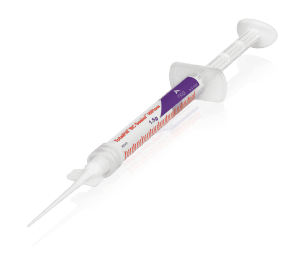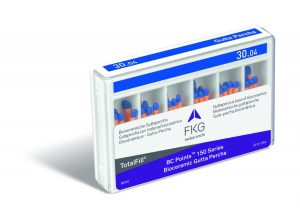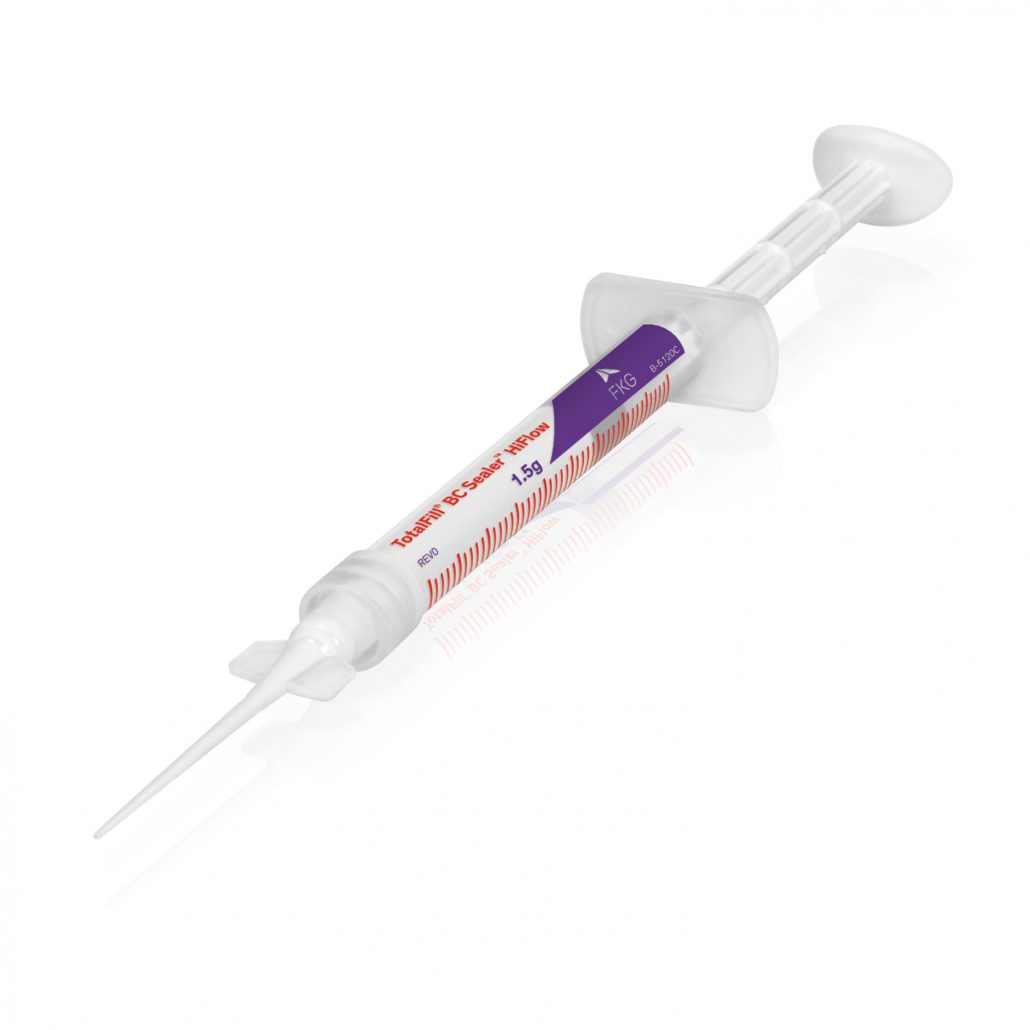TotalFill HiFlow
Sealer med forbedret flyteevne
Internasjonale forskere har i mer enn et tiår dokumentert TotalFill (BC sealer) som en unik sealer. DRs. Spangberg, Haapasalo, Kim, Setzer og Kohli er noen av dem. Det som er tydelig vist, er at sealeren er fullstendig biokompatibel for pulpale celler (1-15), og at den er et fantastisk pulpakappingmiddel fordi den øker odontoblastenes spredning, remineralisering og osteognese (8-10,14-18). I tillegg viser den signifikant anti-bakteriell effekt (19-21) og forsegler lik MTA (22-29). Når det i tillegg er vist en liten ekspansjon (31) ved herding (0,2 %) i motsetning til andre sealere som krymper ved herding, bør skifte av sealer ikke være vanskelig.
HiFlow – lettflytende
Den nye HiFlow består av akkurat det samme som standard TotalFill, men med mindre partikkelstørrelse. Den har dermed lavere viskositet og forbedret flyteevne. Dette gjør også at sealeren tåler høyere temperaturer, opp til 220 grader, uten å dehydrere. Fuktighet er en essensiell faktor i herding av biokeramiske materialer. TotalFill HiFlow er derfor ideell til varm guttaperkateknikk.
- Lavere viskositet
- 20 % bedre røntgenkontrast
- Optimal for termoplastisk teknikk
Termoplastisk og lateralkondenserings teknikk
Det er mulig å bruke standard guttaperkapoint sammen med TotalFill HiFlow. Men vi anbefaler bruk av BC points for få optimalt resultat fordi det dannes en kjemiske binding mellom de coatede BC-pointene og sealeren. For termoplastisk teknikk anbefales TotalFill BC Points 150 serien, sammen med TotalFill BC Pellets ved 150 °C – 220 °C.
Mer info:
- Zhang W, Li Z, Peng. Ex vivo cytotoxicity of a new calcium silicate-based canal filling material. Int Endod J. 2010;43(9):769.
- Jingzhi M, Shen Y, Stojicic S, Haapasalo M. Biocompatibility of two novel root repair materials. J Endod. 2011;37(6):793-798.
- Alanezi AZ, Jiang J, Safavi KE, Spangberg LSW, Zhu Q. Cytotoxicity evaluation of endosequence root repair material. Oral Surg Oral Med Oral Path Oral Radiol Endod. 2010;109(3):122-125.
- Ruparel NB, Ruparel SB, Chen PB, Ishikawa B, Diogenes A. Direct effect of endodontic sealers on trigeminal neuronal activity. J Endod. 2014;40(5):683-687.
- Chang SW, Lee SY, Kang SK, Kum KY, Kim EC. In vitro biocompatibility, inflammatory response, and osteogenic potential of 4 root canal sealers: Sealapex, Sankin apatite root sealer, MTA Fillapex, and iRoot SP root canal sealer. J Endod. 2014;40(10):1642-1648.
- Ciasca M, Aminoshariae A, Jin G, Montagnese T, Mickel A. A comparison of the cytotoxicity and proinflammatory cytokine production of EndoSequence root repair material and ProRoot mineral trioxide aggregate in human osteoblast cell culture using reverse-transcriptase polymerase chain reaction. J Endod. 2012;38(4):486-489.
- Hirschman W, Wheater M, Bringas J, Hoen M. Cytotoxicity comparison of three current direct pulp-capping agents with a new bioceramic root repair putty. J Endod. 2012;38(3):385-388.
- Zhou HM, Du TF, Shen Y, Wang ZJ, Zheng YF, Haapasalo M. In vitro cytotoxicity of calcium silicate–containing endodontic sealers. J Endod. 2015;41(1):56-61.
- Shi ZF, Bao Y, Liu DD, Zhang X, Chen LM, Jiang, Zhong M. Comparison of in vivo dental pulp responses to capping with iRoot BP Plus and mineral trioxide Aggregate. Int Endod J. 2015;49(2):154-160.
- Öncel Torun Z, Torun D, Demirkaya K, Yavuz ST, Elçi MP, Sarper M, Avcu F. Effects of iRoot BP and white mineral trioxide aggregate on cell viability and the expression of genes associated with mineralization. Int Endod J. 2015; 48(10): 986-993.
- Liu S, Wang S, Dong Y. Evaluation of a bioceramic as a pulp capping agent in vitro and in vivo. J Endod. 2015;41(5):652-657.
- Shinbori N, Grama AM, Patel Y, Woodmansey K, He J. Clinical outcome of endodontic microsurgery that uses EndoSequence BC root repair material as the root-end filling material. J Endod. 2015;41(5):607-612.
- Chen I, Karabucak B, Wang C, et al. Healing after root-end microsurgery by using mineral trioxide aggregate and a new calcium silicate-based bioceramic material as root-end filling materials in dogs. J Endod. 2015;41(3):389-399.
- Khalil WA, Abunasef SK. Can mineral trioxide aggregate and nano-particulate EndoSequence root repair material produce injurious effects to rat subcutaneous tissues? J Endod. 2015;41(7):1151-1156.
- Zhang S, Yang X, Fan M. BioAggregate and iRoot BP Plus optimizes the proliferation and mineralization ability of human dental pulp cells. Int Endod J. 2013;46(10):923-929.
- Zhang W, Li Z, Peng B. Effects of iRoot SP (aka BC Sealer™) on mineralization-related genes expression in MG63 cells. J Endod. 2010;36(12):1978-1982.
- Machado J, DDS, Johnson JD, Paranjpe A. Effects of EndoSequence root repair material on differentiation of dental pulp cells. J Endod. 2016;42(1):101-105.
- Chen I, Salhab I, Setzer FC, Kim S, Nah HD. A new calcium silicate–based bioceramic material promotes human osteo- and odontogenic stem cell proliferation and survival via the extracellular signal-regulated kinase signaling pathway. J Endod. 2016;42(3):480-486.
- Zhang H, Shen Y, Ruse ND, Haapasalo M. Antibacterial activity of endodontic sealers by modified direct contact test against Enterooccus faecalis. J Endod. 2009;35(7):1051-1055.
- Lovato K, Sedgley M. Antibactieral activity of EndoSequence root repair material and ProRoot MTA against clinical isolates of Enterococcus faecalis. J Endod. 2011;37(11):1542-1546.
- Wang Z, Shen Y, Haapasalo M. Dentin extends the antibacterial effect of endodontic sealers against Enterococcus faecalis biofilms. J Endod. 2014; 40(4):505-508.
- Lovato K, Sedgley M. Antibactieral activity of EndoSequence root repair material and ProRoot MTA against clinical isolates of Enterococcus faecalis. J Endod. 2011;37(11):1542-1546.
- Wang Z, Shen Y, Haapasalo M. Dentin extends the antibacterial effect of endodontic sealers against Enterococcus faecalis biofilms. J Endod. 2014; 40(4):505-508.
- Zhang W, Zhi L, Peng B. Assessment of a new root canal sealer’s apical sealing ability. Oral Sur Oral Med Oral Path Oral Radiol Endod. 2009;107(6):79-82.
- Nagas E, Uyanik MO, Eymirli A, et al. Dentin moisture conditions affect the adhesion of root canal sealers. J Endod. 2011;38(2):240-244.
- Leal F, De-Deus G, Brandao C, Luna A, Souza E, Fidel S. Similar sealability between bioceramic putty ready-to-use repair cement and white MTA. Braz Dent J. 2013;24(4):362-366.
- Ersahan S, Aydin C. Dislocation Resistance of iRoot SP (aka BC Sealer), a calcium silicate-based sealer, from radicular dentine. J Endod. 2010;36(12):2001-2002 .
- Ghoneim AG, Lutfy RA, Sabet NE, Fayyad DM. Resistance to fracture of roots obturated with novel canal-filling systems. J Endod. 2011;37(11):1590-1592.
- Jiang Y, et al. A comparative study on root canal repair materials: a cyto-compatibility assessment in L929 and MG63 Cells. Scientific World Journal. 2014.
- DeLong C, He J, Woodmansey KF. The effect of obturation technique on the push-out bond strength of calcium silicate sealers. J Endod. 2015;41(3);385-388.
- Richardson IG. The calcium silicate hydrates. Cement and Concrete Research. 2008;38(2):137-158.




